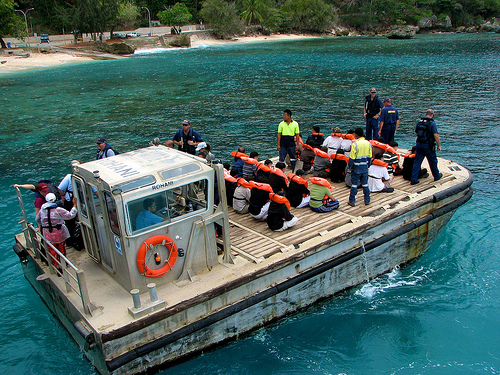
Daily Telegraph fuels refugee myths
“Come by boat and get a visa.”
That was the headline in an article published in last weekend’s Sunday Telegraph (31 Oct 2010). To reinforce the message is a picture of an intercepted vessel headed for Christmas Island. Accompanied by a couple of uniformed Australian officials are a dozen huddled asylum seekers seated next to each other aboard the boat. The caption to the image reads, simply, “Better chance…”
The premise of the article is spelled out in bold in the first two lines:
“ASYLUM-SEEKERS who arrive unlawfully in Australia have a far greater chance of gaining a visa than those applying from outside the country, according to official figures.”
The next 400 words go on to quote these official figures deduced from the Department of Immigration and Citizenship’s latest annual report for 2009-10. If it is not already obvious to the reader, the conclusion is made explicit by a quote from opposition immigration spokesman Scott Morrison who says that it is “fundamentally unfair” that those who arrive unlawfully have a greater chance of remaining in the country.
Clearly the implication of the article is that asylum seekers who arrive by boat are cheating the system because they are (a) unlawful, (b) jumping the queue and (c) are encouraged to do so by being rewarded with a higher acceptance rate level from DIAC.
Unsurprisingly, these conclusions are not lost upon The Telegraph’s readers who comment on the article with statements such as,
“The real refugees in overseas detention camps miss out while cashed up economic immigrants who can afford to fly to Indonesia then pay for a boat ride to Australia get a visa.”
These myths have been disproved time and time again. Yet, for reasons unknown, articles in the media like last week’s Sunday Telegraph continue to publish them; fuelling the misplaced public outrage at innocent asylum seekers who bear the consequences from increased support for draconian government policies. It is worth revisiting and dispelling these myths again.
(a) Asylum seekers are not “illegal” or “unlawful.” Article 31 of the Refugee Convention prohibits countries imposing penalties on asylum seekers who enter without authorisation as it recognises that there is good cause for their entry.
(b) Asylum seekers are not queue jumpers. ALL of the world’s 10 million refugees have crossed at least one boarder without waiting in any queue. 9 million have found protection in this way. Unfortunately, the remaining 1 million or so find themselves in a country in which there are no durable solutions and so wait to be resettled to a third country. In other words, there is no orderly queue.
(c) Asylum seekers are unfairly rewarded for their illegal entry with higher acceptance rates. Seeking asylum is a right for every human being. Providing asylum is not a reward granted by Australia but an affirmation and an obligation of our international commitment to human rights.
Despite the facts, The Telegraph persists in attempting to substantiate these fallacies by drawing upon allegedly official figures from DIAC’s latest annual report, however, errors in fact and interpretation abound. For example, the article claims that,
“Only 9236 of the 47,122 asylum-seekers who applied for visas from overseas received them, which was fewer than 20 per cent of all applications. But for unlawful arrivals, including those who turned up on boats, more than half who applied for visas were granted them – 4697 out of the 8150 who applied.”
The implication is that it is easier to get a visa onshore as an “unlawful” asylum seeker, than offshore, using legal channels. This is a simplistic argument and is not evidenced from the figures provided which are quoted inaccurately from DIAC’s report. For example, the 4697of 8150 applicants who applied for asylum onshore includes all arrivals, lawful and unlawful, arriving by both boat and plane – not just unlawful arrivals as reported in the article (see p. 105 & 111-114 of DIAC’s annual report). Furthermore, applicants who arrive in one year do not necessarily receive a decision in the same year, rendering imprecise any comparative statistics.
The fact of the matter is The Telegraph did not have to perform all of this arithmetic gymnastics to arrive at the conclusion that boat arrivals are more likely to receive a visa than offshore applicants; it is implicit in the operation of Australia’s Refugee and Humanitarian Program. While it is possible to grant ALL onshore applicants protection visas once they are found to be refugees because their numbers are so small, strict limits are imposed on all offshore applicants because the numbers are far greater. That means the percentage of offshore visa grants is always going to be artificially low because the number of refugees in camps overseas vastly outweigh Australia’s quota.
This rational interpretation of the numbers, along with a proper understanding of the inherently disorderly process that constitutes international refugee flows, makes it clear that there is nothing amiss in the larger acceptance rates for onshore arrivals. The Telegraph’s framing of the issue, however, implies there is something unjust in the acceptance of undocumented asylum seekers, fuelling the myth that they are unlawful queue jumpers who are cheating Australia’s otherwise generous and orderly refugee program.
Such mistakes are unacceptable. The Telegraph has a responsibility to hold itself to a higher level of journalistic integrity, especially given the high stakes involved in the treatment of some of the world’s most vulnerable and traumatised human beings.
Leave a reply

Connect with us
Need help from the ASRC? Call 03 9326 6066 or visit us: Mon-Tue-Thur-Fri 10am -4pm. Closed on Wednesdays.